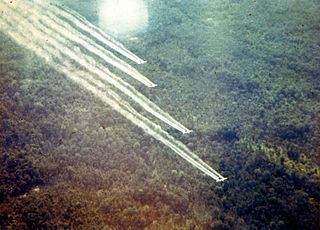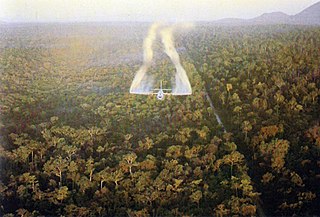Related Research Articles

Agent Orange is a chemical herbicide and defoliant, one of the tactical use Rainbow Herbicides.
Polychlorinated dibenzodioxins (PCDDs), or simply dioxins, are a group of long-lived polyhalogenated organic compounds that are primarily anthropogenic, and contribute toxic, persistent organic pollution in the environment.

Philip Francis Berrigan, SSJ was an American peace activist and Catholic priest with the Josephites. He engaged in nonviolent, civil disobedience in the cause of peace and nuclear disarmament and was often arrested.

Operation Ranch Hand was a U.S. military operation during the Vietnam War, lasting from 1962 until 1971. Largely inspired by the British use of 2,4,5-T and 2,4-D during the Malayan Emergency in the 1950s, it was part of the overall herbicidal warfare program during the war called "Operation Trail Dust". Ranch Hand involved spraying an estimated 19 million U.S. gallons (72,000 m3) of defoliants and herbicides over rural areas of South Vietnam in an attempt to deprive the Viet Cong of food and vegetation cover. Areas of Laos and Cambodia were also sprayed to a lesser extent. Nearly 20,000 sorties were flown between 1961 and 1971.

A defoliant is any herbicidal chemical sprayed or dusted on plants to cause their leaves to fall off. Defoliants are widely used for the selective removal of weeds in managing croplands and lawns. Worldwide use of defoliants, along with the development of other herbicides and pesticides, allowed for the Green Revolution, an increase in agricultural production in mid-20th century. Defoliants have also been used in warfare as a means to deprive an enemy of food crops and/or hiding cover, most notably by the United Kingdom during the Malayan Emergency and the United States in the Vietnam War. Defoliants were also used by Indonesian forces in various internal security operations.

Agent Purple is the code name for a powerful herbicide and defoliant used by the U.S. military in their herbicidal warfare program during the Vietnam War. The name comes from the purple stripe painted on the barrels to identify the contents. Largely inspired by the British use of herbicides and defoliants during the Malayan Emergency, it was one of the so-called "Rainbow Herbicides" that included the more infamous Agent Orange. Agent Purple and Orange were also used to clear brush in Canada.

Herbicidal warfare is the use of substances primarily designed to destroy the plant-based ecosystem of an area. Although herbicidal warfare use chemical substances, its main purpose is to disrupt agricultural food production and/or to destroy plants which provide cover or concealment to the enemy, not to asphyxiate or poison humans and/or destroy human-made structures. Herbicidal warfare has been forbidden by the Environmental Modification Convention since 1978, which bans "any technique for changing the composition or structure of the Earth's biota".

Agent White is the code name for a herbicide used by the U.S. military in its herbicidal warfare program during the Vietnam War. The name comes from the regulatory requirements of identifying each container of the various herbicides through the addition of colored stripes. Orange, purple, pink, blue, and white were colors used by the manufacturers to ensure that the contents were easily identifiable in shipment and use. Colors were selected by the U.S. government. Largely inspired by the British use of herbicides and defoliants during the Malayan Emergency, it was one of the so-called "rainbow herbicides".

Agent Green is the code name for a powerful herbicide and defoliant used by the U.S. military in its herbicidal warfare program during the Vietnam War. The name comes from the green stripe painted on the barrels to identify the contents. Largely inspired by the British use of herbicides and defoliants during the Malayan Emergency, it was one of the so-called "Rainbow Herbicides". Agent Green was only used between 1962 and 1964, during the early "testing" stages of the spraying program.

2,4,5-Trichlorophenoxyacetic acid, a synthetic auxin, is a chlorophenoxy acetic acid herbicide used to defoliate broad-leafed plants. It was developed in the late 1940s, synthesized by reaction of 2,4,5-Trichlorophenol and chloroacetic acid. It was widely used in the agricultural industry until being phased out, starting in the late 1970s due to toxicity concerns. Agent Orange, a defoliant used by the British in the Malayan Emergency and the U.S. in the Vietnam War, was equal parts 2,4,5-T and 2,4-D. 2,4,5-T itself is toxic with a NOAEL of 3 mg/kg/day and a LOAEL of 10 mg/kg/day. Agent Pink contained 100% 2,4,5-T. Additionally, the manufacturing process for 2,4,5-T contaminates this chemical with trace amounts of 2,3,7,8-tetrachlorodibenzo-p-dioxin (TCDD). TCDD is a carcinogenic persistent organic pollutant with long-term effects on the environment. With proper temperature control during production of 2,4,5-T, TCDD levels can be held to about .005 ppm. Before the TCDD risk was well understood, early production facilities lacked proper temperature controls and individual batches tested later were found to have as much as 60 ppm of TCDD.

Agent Pink is the code name for a powerful herbicide and defoliant used by the U.S. military in its herbicidal warfare program during the Vietnam War. The name comes from the pink stripe painted on the barrels to identify the contents. Largely inspired by the British use of herbicides and defoliants during the Malayan Emergency, it was one of the rainbow herbicides that included the more infamous Agent Orange. Agent Pink was only used during the early "testing" stages of the spraying program before 1964.

The Rainbow Herbicides are a group of tactical-use chemicals used by the United States military in Southeast Asia during the Vietnam War. Success with Project AGILE field tests with herbicides in South Vietnam in 1961 and inspiration from the British use of herbicides and defoliants during the Malayan Emergency in the 1950s led to the formal herbicidal program Trail Dust. Herbicidal warfare is the use of substances primarily designed to destroy the plant-based ecosystem of an agricultural food production and/or to destroy foliage which provides the enemy cover.

The War Remnants Museum is a war museum at 28 Vo Van Tan, in District 3, Ho Chi Minh City (Saigon), Vietnam. It contains exhibits relating to the First Indochina War and the Vietnam War.
The Vietnam Friendship Village is a residency founded in 1992 by George Mizo, an American veteran of the Vietnam War. The institution serves individuals afflicted by conditions related to Agent Orange while also opening channels of cross-cultural dialogue. Originally conceived of as a residence for children and elderly people presumed to be victims of Agent Orange, the focus of the village has broadened, and it now provides a variety of services such as alternative health treatments, food grown in an onsite garden, and vocational training.

Study of the environmental impact of war focuses on the modernization of warfare and its increasing effects on the environment. Scorched earth methods have been used for much of recorded history. However, the methods of modern warfare cause far greater devastation on the environment. The progression of warfare from chemical weapons to nuclear weapons has increasingly created stress on ecosystems and the environment. Specific examples of the environmental impact of war include World War I, World War II, the Vietnam War, the Rwandan Civil War, the Kosovo War and the Gulf War.

A Street to Die is a 1985 Australian film directed by Bill Bennett and starring Chris Haywood, Jennifer Cluff, Arianthe Galani. It was nominated for four Australian Film Institute Awards; Haywood won the award for Best Actor in a Lead Role. At the Karlovy Vary International Film Festival, Bennett won a Crystal Globe. The film was based on a true story.

Agent Orange Act of 1991 establishes provisions for the National Academy of Sciences to analyze and summarize scientific evidence regarding presumptive military service exposure to defoliants, dioxins, and herbicides, better known as Agent Orange, during the Vietnam War era. The United States Statute endorses an observation of human medical conditions directly related to non-Hodgkin lymphoma, soft-tissue sarcoma, chloracne, and consistent acneform diseases for military personnel who served in the overseas Vietnamese region. The Act of Congress ratifies a medical research compilation of voluntarily contributed blood and tissue samples provided by Vietnam-era veterans serving in Southeast Asia between 1961 and 1975.
Agent Orange is a herbicide, classified as a defoliant, that was used most notably by the U.S. military during the Vietnam War. Its primary purpose was strategic deforestation, destroying the forest cover and food resources necessary for the implementation and sustainability of the North Vietnamese style of guerilla warfare. The U.S. Agent Orange usage reached an apex during Operation Ranch Hand, in which the material was sprayed over 4.5 million acres of land in Vietnam from 1961 to 1971.

Lighter than Orange-The Legacy of Dioxin in Vietnam is a documentary by the Berlin filmmaker Matthias Leupold about the long-term consequences of American warfare in Vietnam. The film was shot in Vietnam in 2012 and has been subtitled in English, German, French, Spanish, Italian, Vietnamese and Russian. The film documents stories of Vietnamese veterans and their families who are affected by the gene damage caused by the defoliant Agent Orange. It contained 2,3,7,8-tetrachlorodibenzodioxin.
Carol Van Strum is an American environmental activist who since 1975 has fought against the spraying of herbicides, including Agent Orange, in the Siuslaw National Forest in Oregon. Her subsequent research, including over 20,000 documents revealing corporate and government cover-ups, was donated to the Poison Papers project in 2017. In 2018, Van Strum received the David Brower Lifetime Achievement Award for her contributions to forestry policy favoring selective harvest without the use of herbicides.
References
- 1 2 Ithaca College: Faculty
- ↑ Rebekah Wilce, "Through the Toxic Mirror: Vietnamese and Americans Continue to Suffer Effects of Agent Orange" PRWatch. September 12, 2012.
- ↑ George Claxton
- ↑ "Vietnam in the Aftermath of a Chemical Holocaust". HuffPost. 2013-04-03. Retrieved 2023-04-20.
- ↑ "UNCOMMON MARTYRS | Kirkus Reviews".
Reference 2: Note that Wilce makes the incorrect assertion that Wilcox "broke" the story of Agent Orange. He did not, but this book uncovers much new information about its use and effects on U.S. soldiers and personnel in Vietnam during and after their service there.